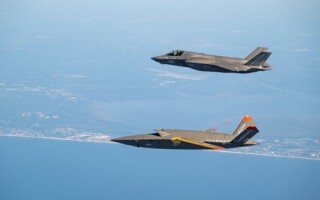Demand for RF technology for electronic warfare & radar systems increases
StoryJune 30, 2016

Increased demand for electronic warfare (EW) systems and radar modernization means opportunities as well as increased pressure to innovate for RF & microwave suppliers. In this Q & A with Ian Dunn, Vice President and General Manager of the Embedded Products Group in Mercury Systems? Commercial Electronic Business unit, he discusses this market trend as well as his company?s acquisition of the RF & microwave business from Microsemi, where open architecture and COTS fit in EW systems, and enabling security in future sensor networks.
MCHALE REPORT: Please provide a brief description of your responsibility within Mercury Systems and your group’s role within the company.
DUNN: I am Vice President and General Manager of the Embedded Products Group, part of Mercury Systems’ Commercial Electronics business unit. The group encompasses all of the traditional Mercury computing systems and some new investments in secure processing as well as system integration.
MCHALE REPORT: For many years Mercury Systems was seen as a large embedded computing supplier for intensive signal processing applications such as radar and electronic warfare (EW). Now the company has acquired key business lines from Microsemi including their RF and microwave group. Does this acquisition change how Mercury defines itself in the military market? If so, how?
DUNN: This acquisition is right in line with the transformation we’ve been going through since 2007 when Mark Aslett took over as CEO. He performed divestures of some of our non-performing businesses in 2008 and 2009 and restored the economic core of the company to focus on embedded computing for defense, then laid out a plan with the management team to transform Mercury into a subsystems company. Mercury went from building just blades to building complete embedded computer subsystems, which set the foundation.
Based on conversations with our customer base we then focused on adding missing elements such as RF and microwave. Our customers told us that to be in the subsystem business, our systems need to be application-ready with RF capability in the designs and with the necessary manufacturing capacity to back it up.
MCHALE REPORT: Will the acquired Microsemi businesses keep their branding or be rebranded as Mercury Systems divisions and products?
DUNN: There is only one brand – Mercury Systems – and we have been pretty disciplined about that inside and outside the company. As we’ve brought acquisitions online we’ve often sold assets that were not a fit investment or culture wise. All of these actions have been strategic, meaning not simply buying something and stripping it down into subset of capability, but rather building a creative engineering organization complimentary to the company’s sensor chain strategy.
As far as reorganization is concerned the acquired Microsemi businesses fit very nicely into our portfolio. Microsemi over its years of acquiring companies kept their inherent engineering culture intact. They acquired a couple RF institutions centered on a core expertise that we will preserve within Mercury. The Microsemi facilities we acquired will remain, increasing our global footprint, such as those in San Jose and Camarillo, California. This is somewhat different than our past strategy, which was to have facilities kept close together geographically. One unwritten rule within the military RF and microwave business is that customers buy near where their engineers reside. This is not same in the computing market because the work can be done in software.
MCHALE REPORT: Will there be consolidation, staff reduction or other major reorganizations?
DUNN: Our strategic acquisition goal is to grow the acquired business in a way that is complementary to other Mercury businesses.
MCHALE REPORT: Radar and EW are defense applications that have shown steady growth the last few years. How do you see the market for each application today and going forward the next few years? Where will the most opportunities reside? In radar upgrades? New EW systems?
DUNN: We still think the fundamental growth area for the company is in EW with the right mix of RF capability to do broadband systems, getting as close to the antenna as we can get. You will see that in our marketing and the way we organize along the sensor chain. There is also a modernization revolution on the horizon in radar with elemental digital tiles. The U.S. government, defense prime contractors, and others are working to bring that to fruition.
If the radar revolution occurs in the near term it will create a tremendous computing challenge for designers to enable the tile concept in small, affordable solutions that are adaptable to meet the variety of threats out there.
For example, Mercury’s signal processing solutions are deployed in the Patriot Air & Missile Defense System’s radar and other defense radar and EW modernization programs.
MCHALE REPORT: Last month in San Francisco the RF and microwave community gathered for the International Microwave Symposium (IMS). What military RF and microwave design trends are you seeing emerging in this community?
DUNN: In the sensor chain from the network on back there is a need for more multifunction systems. This puts pressure on designers to architect a system that enables multi-spectrum digital acquisition while simultaneously designing for multifunction capability to adapt to different threats. There is also a lot of pressure to reduce SWaP in these systems.
MCHALE REPORT: Are you seeing an increased demand for commercial-off-the-shelf (COTS) technology and open architectures from your defense customers – in signal processing and RF & microwave designs?
DUNN: What if open architecture can play any role in this area? You can custom design the antenna, then build a custom distribution system for that antenna, and then connect to a COTS solutions. The antenna will likely stay a custom solution, but will distribution logic? This is not clear yet, but maybe if the right technology comes along.
Digital acquisition architecture? We have developed a portfolio to have that conversation with customers, talk about trade-offs and as part of our research and development are looking at what if any open architecture elements apply to enable multi-functionality more affordable and more configurable.
Right now you can take the custom antenna all the way through to digital acquisition. Custom designs and multi-functionality are not equal. Customization has limitations, as it does not necessarily enable affordability and adaptation of new technology in the long run.
MCHALE REPORT: In 2014 you penned an article for Military Embedded Systems titled “Is open delaying the future of cognitive computing.” A concept called cognitive EW is gaining traction in military circles. Can it thrive with open architectures and standards? How does Moore’s Law play in the RF & microwave world?
DUNN: I alluded to a challenge there. If you can push my premise that proprietary architecture brings cognitive capability to life faster than with an open architecture, then there will be a fundamental delay before you have an open alternative. You are going to start to see open cognitive libraries. For example, Elon Musk [founder of PayPal] has announced that he will use open AI [artificial intelligence] as a tool for architecting intelligent cognitive capability. We are already seeing this concept developing and the Moore’s Law engine will allow it to happen. In five years consumers will get five times the computing performance for the same price.
For the DoD the problem is that cognitive data in the digital world is about data in the spectral world and for them converting the spectral environment into a searchable, exploitable, digital environment is an open architecture challenge in RF. To solve that we’re investing in designs that move the open architecture interface closer to the antenna. The big dream is having an Ethernet interface on the back of antenna, enabling the antenna to see a fair amount of spectrum, which will enable the spectrum to be more exploitable.
It will most likely happen in the commercial world first, but DoD agencies such as DARPA can accelerate the adoption curve, not meaning that they deploy it, but that they can demonstrate the power of cognitive operations in spectral environments.
MCHALE REPORT: Looking forward, what disruptive technology/innovation will be a game changer in RF & microwave as well as signal processing applications? Predict the future.
DUNN: One is direct digitization and we’re amassing a portfolio for a day when direct digitization is possible. Currently it is not possible without more mixed analog infrastructure going into the chip itself because the broader you get the more you need RF circuitry in front of the device to shape the spectrum and to make it flatter and more linear in behavior.
Another is secure networking. The DoD has to get a lot smarter about secure processing and networking to realize the future of large sensor networks such as a future manned or unmanned aircraft with 100 sensors feeding a network of consumers across the globe.
Ian Dunn, VP and General Manager of the Embedded Products Group within Mercury Systems’ Commercial Electronics business unit, is responsible for embedded product development across the entire sensor processing chain. Previously, he was VP and General Manager of Mercury’s Microwave and Digital Solutions Group. Before that he was the company’s CTO responsible for technology strategy and R&D projects. Dr. Dunn joined the company in 2000 as a systems engineer upon completing a Ph.D. at Johns Hopkins University in Electrical Engineering. As a doctoral student at Johns Hopkins, Dr. Dunn consulted for Disney Imagineering and Northrop Grumman on distributed automation and various high-performance computing projects. He has 20 years of experience designing and programming parallel computers for real-time signal processing applications and has authored numerous papers and a book on designing signal processing applications for high-performance computer architectures.






